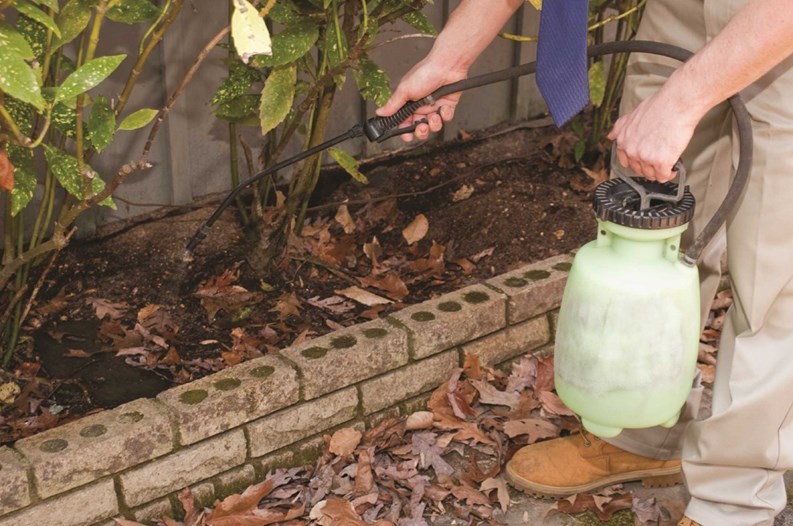Since the 1950s, American lawns have been “hooked” on petroleum-based and synthetic chemicals. A plethora of post-war pesticides, herbicides, fungicides and fertilizers were eagerly embraced by both homeowners and landscape professionals dazzled by the dramatic results; an almost instantaneous, lush, green lawn. There was a downside, however. Grasses become dependent on an endless feed of chemicals for their sustenance, and the underlying soil became sterile and inhospitable. Take away the chemicals, and the lawn quickly withered and went brown, unable to sustain itself.
Today, many landscape industry experts compare a lawn suffering from the all-chemical approach to a drug addict who cannot function without a fix. An emerging trend of using more organic and eco-friendly methods has been trying to address the detrimental effects of using chemical products by introducing a variety of products and practices that are more sustainable and often, less expensive.
Damaging Effects
An important reason for going organic with landscape care is creating a healthier environment for people and pets. One of the reasons people became more wary of using harsh chemical products was their pet's adverse reaction to them.
“I think that was a real big push with people complaining that their pets' paws were getting burnt with some of the chemicals that were out there,” according to Gordon Held, executive vice president of operations and sales for an Illinois-based landscaping company. And then, of course, that just started opening eyes of people saying, 'If it hurts the dogs, what's it doing to the humans?',” he says.
The fact that lawn chemicals are inherently dangerous is no secret—just read the warning labels on the packaging. Held and other landscape experts agree that the damaging effects of chemical pesticides are primarily due to their all-too-frequent misapplication.
“The threat is the applicator,” Held says. “If the pesticide is not properly mixed, or the person is not properly trained, and [the treatment] not properly applied, that's when it becomes dangerous. Issues that cause damage are things like applying a pesticide in high winds, creating drift, for example. Or applying it in such a way that it leaches into drain systems and waterways. Things of that nature.”
Going for the Green
Organic and eco-friendly landscaping includes two main components: one is using organic, less chemically destructive products and methods. But more importantly, it involves a change in landscaping management, such as using more preventative care and targeting applications to specific problems. One such practice is called Integrated Pest Management or IPM.
“This approach uses pest scouting and preventive practices to limit pesticide use. Many companies will offer an IPM program as a hybrid between organic and conventional where pesticides are only used sparingly as needed,” says Mike Bucuk, manager of the organic lawn and plant care at Green Path Organic Landcare in Green Village.
Eric Cross, president of Duke's Landscaping Management Inc. in Hackettstown, explains that the thrust of IPM is selecting and taking care of trees and plants so that they are more naturally resilient to pests, thus reducing the need to apply more pesticides and chemicals. For example, if you have a tree that is continually getting fungus, instead of constantly applying fungicide, you may cut it down and replace it with a different tree or replant it in a location with more sun. Companies will also select more native species of plants because they already have a built in immunity to the climate and environment which can eliminate or mitigate many pest problems that communities are having.
In order to use less chemicals, landscaping companies are being more selective with how and where they spray them. Instead of spraying entire areas of turf, called a blanket application, companies will now only focus on the area that needs the pesticide.
“Part of IPM is only making applications when it's necessary. We were kind of trained as Americans that if we had a dandelion we need to do a blanket application on the whole lawn, we need to make five applications per year and we're kind of brainwashed into thinking that was the way to go,” says Cross. “A lot of what [large conventional companies] used to do in the past is they'd make one tank and then in that tank they put a herbicide, a fungicide, an insecticide and a fertilizer. If they sprayed 50 lawns in a day everybody got all that stuff if they needed it or not. That guaranteed a green lawn but it also was very detrimental to the environment. So, today we do a lot more visual inspections and we do small applications.”
An aesthetic challenge with IPM is that your lawn or landscape may not be as pristine as before. You might have to accept the occasional dandelion.
“If there's a dandelion, there's a dandelion. It's not the end of the world. Nobody will get hurt. There's a tolerance factor that has to go up and has gone up for a lot of people. They realize, ‘okay, we can wipe out all the dandelions but at what cost financially and environmentally at the same time,’ ” says Cross.
What Will it Cost?
Financing organic and partially organic landscaping may be a concern for many boards whose budgets may not have room to incorporate more expensive or frequent landscape treatment. Surprisingly, greener products and practices may not be as costly as you think.
“It's really not more expensive if you do it properly. The fact is we can save the client money because in the olden days we use to do, if the specifications called for it, a blanket application of an insecticide for example. We don't do that now. We'll do our dormant oil which is an oil application early to suffocate the insect and then we will do an IPM program for a visual inspection on all applications. We're using a lot less product but it's limited to the client part. So, it costs about the same but we reduce the pesticide usage quite a bit,” says Cross.
He continues that a completely organic program would be expensive, so to reduce costs, companies will also use a combination of organic and synthetic products, which will often achieve better results.
“The problem is that we want chemical-free landscapes to live up to the standards of conventional treatments. That may not always be possible and it may take more labor and materials to achieve the same standards. This is what drives up the cost of organic landscapes. If the client can accept the trade-off of the occasional weed or pest for reducing pesticide use than a sensible organic program can be developed that is similar in cost to conventional programs,” adds Bucuk.
Community Cooperation Required
Safe application of lawn care chemicals within a community requires the cooperation of residents. This includes protocols for preventing contact by people and pets, and that’s where property management gets involved.
“It comes down to a lot of communication with the board or with the property manager,” says Held. “If you know you are going in to do a tree spray on Tuesday night, you have got to let that property manager know so that they can communicate that to the people who live in the building. So that if windows need to be closed, they close the windows or if the turf is going to be sprayed and if they'll let people know. I've seen a couple of different ways to remind people: Phone calls where it just automatically calls people and reminds them "on Wednesday your turf is going to be sprayed" or they put signs out when you are pulling into the property saying your turf spray is on Wednesday.”
Held explains that accommodating sensitive residents can also go back to making modifications in the landscape itself.
“That's been a big push too as far as maybe not so much the chemical aspect of it, but the plant maintenance part of it. Annual beds which typically require a lot of watering and fertilizing can be replaced with perennials and shrubs. Instead of weekly mowing and constant weed spraying and all that fun stuff, irrigation has been replaced with more native species of turf that require less maintenance and care,” he says.
Anti-Chem Laws
The state of New Jersey has been adamant about discontinuing or limiting the use of certain products and practices that have produced negative consequences. On January 5, 2011, the state of New Jersey enacted New Jersey Act P.L. 2010, c. 112 (C.58:10A-64), which established standards for fertilizer applications to turf, required certification of professional fertilizer applicators and regulated labeling and sale of specialty fertilizers for turf.
Bob Greene, branch manager of Duke's Landscape Management Inc. in Rockaway explains that in order to obtain certification, professionals must read an online manual and pass an exam. He says that individuals are still able to apply fertilizer without certification to plants or inject it into the ground and the legislation only covers surface applications.
Greene also adds that homeowners and commercial companies can no longer apply phosphorous to lawns unless a soil test deems it necessary or a new lawn is being established.
As the detrimental effects of using chemical products in landscaping are becoming more exposed, switching your association over to organic products could produce greener results without taking more green out of your budget.
Marie Auger is a freelance writer and a contributor to The New Jersey Cooperator. Editorial Assistant Maggie Puniewska contributed to this article.





Leave a Comment